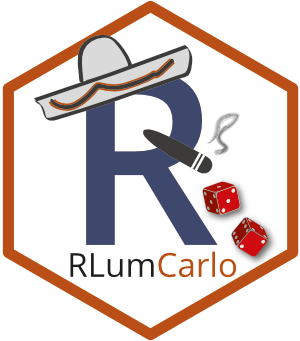Monte-Carlo Methods for Simulating Luminescence Phenomena.
RLumCarlo 
The R package RLumCarlo provides a collection of R functions modelling luminescence production in isolators and semiconductors for various stimulation modes using Monte Carlo methods.
Installation
i. Requirements
Depending on your OS please download and install one of the following:
- Windows: Rtools (provided by CRAN)
- macOS: Xcode (provided by Apple)
- Linux: gcc often comes pre-installed in most distributions. Should gcc be not available, however, we kindly refer to the exhaustive collection of installation guides depending on the Linux distribution.
ii. Install the package from GitHub
if(!require("devtools"))
install.packages("devtools")
devtools::install_github("R-Lum/RLumCarlo@master")
Examples
run_MC_CW_IRSL_TUN(A = 0.12, rho = 0.003, times = 0:1000) %>%
plot_RLumCarlo(norm = TRUE, legend = TRUE)

Supported models
| TRANSITION | BASE MODEL | IRSL | OSL | LM-OSL | TL |
|---|---|---|---|---|---|
| Delocalised | OTOR | FALSE | TRUE | TRUE | TRUE |
| Localised | GOT | TRUE | FALSE | TRUE | TRUE |
| Excited state tunnelling | LTM | TRUE | FALSE | TRUE | TRUE |
License
This program is free software: you can redistribute it and/or modify it under the terms of the GNU General Public License as published by the Free Software Foundation, either version 3 of the License, or any later version.
This program is distributed in the hope that it will be useful, but WITHOUT ANY WARRANTY; without even the implied warranty of MERCHANTABILITY or FITNESS FOR A PARTICULAR PURPOSE. See the GNU General Public License for more details.
Funding
The development of RLumCarlo benefited from the support by various funding bodies:
The initial work by Johannes Friedrich, Sebastian Kreutzer and Christoph Schmidt was supported by the DFG (2015–2018, SCHM 3051/4-1, “Modelling quartz luminescence signal dynamics relevant for dating and dosimetry”, SCHM 3051/4-1).
Later financial support was secured through the project ‘ULTIMO: Unifying Luminescence Models of quartz and feldspar (German Academic Exchange Service) DAAD: Deutscher Akademischer Austauschdienst DAAD PPP USA 2018, ID: 57387041)’.
The work of Sebastian Kreutzer as maintainer of the package was supported by LabEx LaScArBx (ANR - n. ANR-10-LABX-52) between 2017 and 2019.
From 2020, Sebastian Kreutzer received funding from the European Union’s Horizon 2020 research and innovation programme under the Marie Skłodowska-Curie grant agreement No 844457 (project: CREDit).